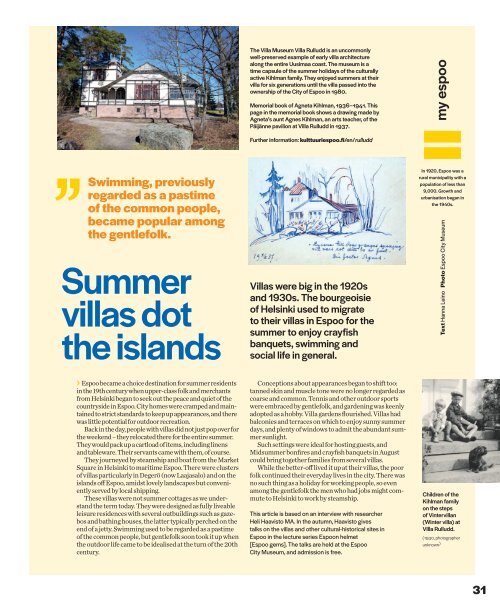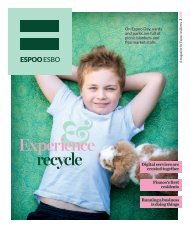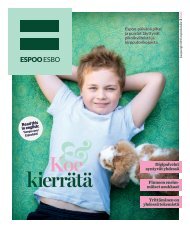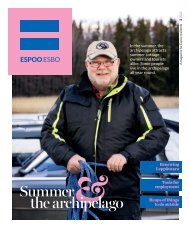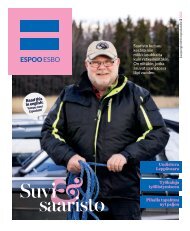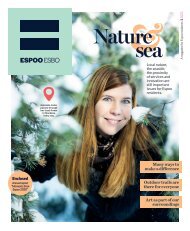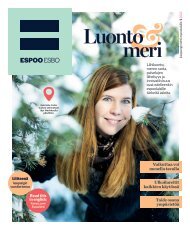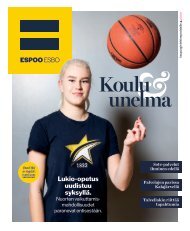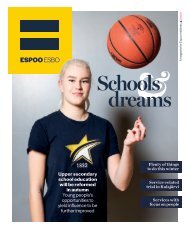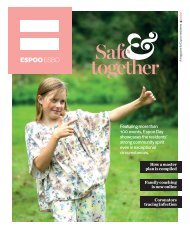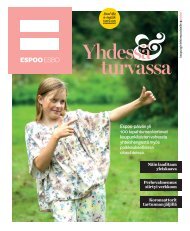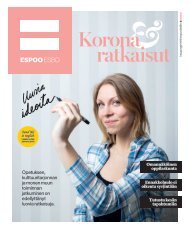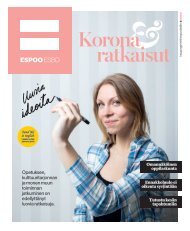ESPOO MAGAZINE 2/2020
A MAGAZINE FOR ESPOO RESIDENTS
A MAGAZINE FOR ESPOO RESIDENTS
Create successful ePaper yourself
Turn your PDF publications into a flip-book with our unique Google optimized e-Paper software.
The Villa Museum Villa Rulludd is an uncommonly<br />
well-preserved example of early villa architecture<br />
along the entire Uusimaa coast. The museum is a<br />
time capsule of the summer holidays of the culturally<br />
active Kihlman family. They enjoyed summers at their<br />
villa for six generations until the villa passed into the<br />
ownership of the City of Espoo in 1980.<br />
Memorial book of Agneta Kihlman, 1936–1941. This<br />
page in the memorial book shows a drawing made by<br />
Agneta’s aunt Agnes Kihlman, an arts teacher, of the<br />
Päijänne pavilion at Villa Rulludd in 1937.<br />
my espoo<br />
Further information: kulttuuriespoo.fi/en/rulludd<br />
Swimming, previously<br />
regarded as a pastime<br />
of the common people,<br />
became popular among ”the gentlefolk.<br />
Summer<br />
villas dot<br />
the islands<br />
Villas were big in the 1920s<br />
and 1930s. The bourgeoisie<br />
of Helsinki used to migrate<br />
to their villas in Espoo for the<br />
summer to enjoy crayfish<br />
banquets, swimming and<br />
social life in general.<br />
In 1920, Espoo was a<br />
rural municipality with a<br />
population of less than<br />
9,000. Growth and<br />
urbanisation began in<br />
the 1940s.<br />
Text Hanna Leino Photo Espoo City Museum<br />
› Espoo became a choice destination for summer residents<br />
in the 19th century when upper-class folk and merchants<br />
from Helsinki began to seek out the peace and quiet of the<br />
countryside in Espoo. City homes were cramped and maintained<br />
to strict standards to keep up appearances, and there<br />
was little potential for outdoor recreation.<br />
Back in the day, people with villas did not just pop over for<br />
the weekend – they relocated there for the entire summer.<br />
They would pack up a cartload of items, including linens<br />
and tableware. Their servants came with them, of course.<br />
They journeyed by steamship and boat from the Market<br />
Square in Helsinki to maritime Espoo. There were clusters<br />
of villas particularly in Degerö (now Laajasalo) and on the<br />
islands off Espoo, amidst lovely landscapes but conveniently<br />
served by local shipping.<br />
These villas were not summer cottages as we understand<br />
the term today. They were designed as fully liveable<br />
leisure residences with several outbuildings such as gazebos<br />
and bathing houses, the latter typically perched on the<br />
end of a jetty. Swimming used to be regarded as a pastime<br />
of the common people, but gentlefolk soon took it up when<br />
the outdoor life came to be idealised at the turn of the 20th<br />
century.<br />
Conceptions about appearances began to shift too:<br />
tanned skin and muscle tone were no longer regarded as<br />
coarse and common. Tennis and other outdoor sports<br />
were embraced by gentlefolk, and gardening was keenly<br />
adopted as a hobby. Villa gardens flourished. Villas had<br />
balconies and terraces on which to enjoy sunny summer<br />
days, and plenty of windows to admit the abundant summer<br />
sunlight.<br />
Such settings were ideal for hosting guests, and<br />
Midsummer bonfires and crayfish banquets in August<br />
could bring together families from several villas.<br />
While the better-off lived it up at their villas, the poor<br />
folk continued their everyday lives in the city. There was<br />
no such thing as a holiday for working people, so even<br />
among the gentlefolk the men who had jobs might commute<br />
to Helsinki to work by steamship.<br />
This article is based on an interview with researcher<br />
Heli Haavisto MA. In the autumn, Haavisto gives<br />
talks on the villas and other cultural-historical sites in<br />
Espoo in the lecture series Espoon helmet<br />
[Espoo gems]. The talks are held at the Espoo<br />
City Museum, and admission is free.<br />
Children of the<br />
Kihlman family<br />
on the steps<br />
of Vintervillan<br />
(Winter villa) at<br />
VIlla Rulludd.<br />
(1930, photographer<br />
unknown )<br />
31


